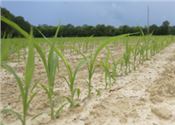|
Grain Sorghum Acreage May Fall To Record Lows

Grain sorghum emerges in this Oktibbeha County field June 14, 2017. Mississippi growers
are projected to plant 10,000 acres of the crop this year, which would be a record low.
Photo by MSU Extension Service/Kevin Hudson
STARKVILLE, MISS.
Insect pressure and a stagnant market are pushing Mississippi growers away from planting grain sorghum.
Compared with 2015, when the state had 120,000 acres of sorghum, producers harvested only about 11,000 acres of the crop in 2016. The U.S. Department of Agriculture forecasted they would plant only 10,000 acres this year. If that prediction holds, 2017 will mark an 88-year low for sorghum production.
Most of this year’s crop, planted in late April and early May, is progressing through vegetative growth stages, which means it is too early make yield predictions. Still, this year’s acreage is unlikely to increase much unless growers plant more sorghum in fields where corn was lost to flooding.
Last year’s production value for sorghum was $4 million compared with $44 million in 2015.
“Two seasons ago, there was tremendous incentive for sorghum production largely based on market demand from China,” said Erick Larson, grain crops specialist with the Mississippi State University Extension Service. “That demand is no longer in place, and the threat from sugarcane aphids presents extra risk and higher maintenance costs. The only wild card that could cause further sorghum planting is flooding associated with high water levels in the Mississippi River system.
“Typically, producers replant soybeans when they lose corn to flooding, but sorghum could be a viable option where corn herbicides applied earlier this spring restrict soybean planting,” he added. “Most sorghum is grown on dryland acreage with limited productivity near major grain facilities near Memphis and along the Mississippi River.”
The sugarcane aphid began appearing in Mississippi sorghum fields in 2014 and has been spreading ever since. Growers have generally mitigated damage from the new insect pest by using strategies developed and delivered by MSU entomology researchers and Extension specialists. However, these strategies require additional labor and expenses.
While this year’s sorghum crop is small, most of it is in good condition for now. USDA estimated 92 percent of the crop was planted as of June 11. The same report characterized the crop as 18 percent excellent, 54 percent good and 27 percent fair.
Though sorghum has long been a secondary row crop in Mississippi, the state finished 10th out of all 50 states in 2016 production of the grain.
“Sorghum is usually planted in high-risk, low-productivity areas,” Larson said. “It is most suitable where the productivity of corn is low or risky. Sorghum prices follow corn prices as a general rule and are usually about 10 percent less.”
Brian Williams, Extension agricultural economist, said the current contract price for Mississippi sorghum is $3.36 per bushel. Cash prices are not yet listed, but contract prices for corn, which sorghum typically mirrors, are running about 10 cents above cash prices. A year ago, sorghum was trading for $2.96 a bushel.
“I don’t see a lot of upside on sorghum acreage unless we see a major market shakeup like we did a few years ago,” Williams said. “Two years ago, China was hesitant to import genetically modified corn and was replacing it with sorghum as a feed source. Lately, the country has relaxed those restrictions. Favorable market conditions for cotton, corn and soybean are making sorghum look much less attractive right now.”
One more issue facing sorghum production is a lack of storage.
“Elevator and grain infrastructure is somewhat limited, putting extra demand for space on elevators that accept grain sorghum,” Larson said. “Only some elevators have plentiful space for grains and can accommodate many bushels of sorghum. Many of those are located in the northern parts of the Delta.” ∆
|
|